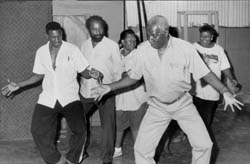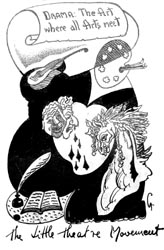CHOREOGRAPHY – TRENDS
IN PANTOMIME
(Taken from souvenir programme 1984/85 Sipplesilver)
 Rex
Nettleford is a household name in Jamaica, in particular
for his outstanding contribution to national and cultural life as
a co-founder and Artistic Director of the National Dance Theatre
Company. He’s had sustained contact with the LTM National
Pantomime since 1959 to the present, as the following records:
Rex
Nettleford is a household name in Jamaica, in particular
for his outstanding contribution to national and cultural life as
a co-founder and Artistic Director of the National Dance Theatre
Company. He’s had sustained contact with the LTM National
Pantomime since 1959 to the present, as the following records:
In 1959, Rex Nettleford returned from Oxford with two years of solid
experience in dance-creation for musicals and revues in Oxford,
at the Edinburgh Festival and at Henley-on-Thames. Henry and Greta
Fowler (on holiday in Oxford in the summer of 1959) caught sight
of Nettleford and of his choreography in Aristophanes – “The
Birds” updated into a rock musical with the music by Dudley
Moore.
Greta then and there pressed Nettleford into service since he was
planning to return home in a matter of months. He was to take over
the choreography of that year’s Pantomime “Jamaica Way”
with Eddy Thomas and Glenna Brydon in the young lovers’ lead
and Robin Midgely (of the Jamaica Broadcasting Corporation) directing.
The young group of dancers (largely from Thomas’ Workshop)
worked as an integral part of the Pantomime cast.
The dance started to advance the plot rather than appear as set
pieces fitted in. In its wake came “Carib
Gold” attracting more of Thomas’ dancers
and ones from the Ivy Baxter Dance Group as well as Yvonne DaCosta
and Pansy Hassan from Faye Simpson’s. Noelle Hill Chutkan
(also from Simpson’s) had long been in Pantomimes, Louise
Bennett and Nettleford co-directed and Nettleford choreographed.
Therewas much dance, some felt too much. The Guyanese tale (about
porkknockers or gold miners) pleased but did not excite audiences.
It was not until 1961 with “Banana
Boy” which Nettleford both directed and choreographed
that the dance made the musical move, in what was then regarded
as the “integrated musical” style. Many of the dancers
involved were to form the nucleus of the NDTC – Barbara Requa
(then Grant), Pansy Hassan (then Silvera), Yvonne daCosta, Gertrude
Sherwood, Bert Rose, Audley Butler.
NDTC’S INFLUENCE
Between 1962 and 1970, dance figured much and choreography in Pantomimes
gained increased popularity. Nettleford acted as an in-house consultant
choreographer to the LTM. Greta Fowler, as President of the LTM
sat on the NDTC Management Committee. From the ranks of the NDTC
within that decade, Eddy Thomas choreographed once, Nettleford three
times, Sheila Barnett twice (the two versions of “Queenie’s
Daughter”), Neville Black once and Joyce Campbell
once.
By 1971, young Jackie Guy, just beginning his career as an NDTC
dancer of merit, was ready to create dances for the Pantomime. He
did so in “Music Boy” with Nettleford as artistic advisor for the entire production.
The next five years of Pantomime were again shared between Eddy
Thomas who choreographed twice and Nettleford who choreographed
three more Pantomimes. By this time (1977) Bert Rose, an NDTC choreographer
and principal dancer, took on “Twelve
Million Dollar Man”. Between 1978 and 1981, Jackie
Guy (by then an established principal dancer with NDTC) resumed
with three Pantomimes to his credit while Patsy Ricketts (widely
acclaimed then as NDTC’s leading principal female dancer)
also did one.
In 1982, Nettleford returned to the boards staging the musical numbers
for “Tantaloo” while Tony Wilson (recently returned to the NDTC from his sojourn
abroad) created a number of set dances for the show. In 1983 it
was again Jackie Guy’s turn with the Barbara Gloudon’s
record-breaking “Ginneral
B’.
CHOREOGRAPHY OR STAGING?
Nettleford has always made a distinctive between the staging of
musical numbers and the choreographing (in the strict sense of conceiving
from scratch and designing movement vocabulary, patterns and style
for a work). Nettleford shifted significantly in “Dickance
for Fippance” (Gloria Lannaman’s tribute
to 1938) by emphasizing the staging of musical numbers and working
for the overall movement effect of the entire production.
“The
Witch” (by Gloudon) was similarly handled, through
the dance of the cat (Patsy Ricketts and Joan McLeod) was a choreographed
piece as was the dance of the Rolling Calf (Michael Binns) in “Brashana
O” (another scripted by Lannaman). Jackie Guy was to follow
this pattern in the work he did in the late Seventies drawing on
the new vocabulary of the urban young “Johnny
Reggae”, “Pirate Princess”and “Ginneral
B”. It is reasonable to speculate whether the turn that dance will take
in future Pantomimes will be greatly influenced by the new video
craze.
Footnote: The LTM continues to use choreographers from
the NDTC for the annual Pantomimes - most recently for the productions "Combolo", "Iffa
Nuh So"and "Zu-Zu
Macca". Prof. Rex Nettleford's last involvement with the Pantomime beofre his death was the 2009/10 "Pirate Jack".
Members of the Pantomime Company include graduates of the Edna Manley
College for the Visual and Performing Arts (School of Dance) and
members of various dance troupes. Dance sequences are fully integrated
with the story line and production numbers. The “staging”
or “movement” of today’s Pantomime strikes a balance
between current dances while still preserving the folk forms of
yesterday. Quadrille, Mento, Dinki-mini, Bruckins sequences often
merge with the latest dance moves seen in the dancehall or night clubs.

